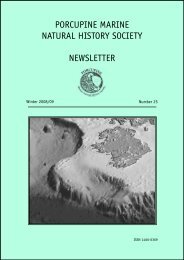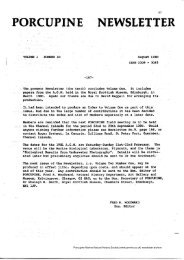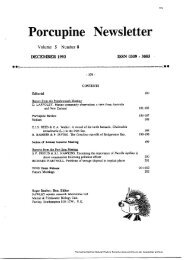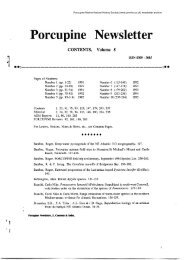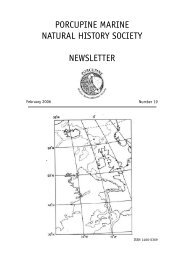PORCUPINE MARINE NATURAL HISTORY SOCIETY NEWSLETTER
PORCUPINE MARINE NATURAL HISTORY SOCIETY NEWSLETTER
PORCUPINE MARINE NATURAL HISTORY SOCIETY NEWSLETTER
You also want an ePaper? Increase the reach of your titles
YUMPU automatically turns print PDFs into web optimized ePapers that Google loves.
22<br />
and only 2-3cm long, the shrimp has some<br />
clear distinguishing features. The chelae are<br />
blue and white striped whilst the thorax is<br />
covered with small blue spots. Its abdomen is<br />
ornated by pinky-white stripes, one of which<br />
is v-shaped and points toward the tail. Finally<br />
the telson is edged by a further blue and white<br />
arrow shaped stripe pointing back toward the<br />
thorax.<br />
Sighting details<br />
An individual P.sagittifer (Norman, 1861)<br />
shrimp was observed on the oral disc of a<br />
solitary A.viridis under the new Swanage Pier<br />
in Swanage, Dorset, UK (grid reference SZ<br />
035 787; 50° 36.501’N, 001° 57.056’W) (Plate<br />
1). Seasearch diver Polly Whyte made the<br />
sighting on 22 September 2007 at 1242h GMT.<br />
Water depth was approximately 3m and the<br />
temperature was approximately 17°C (Suunto<br />
Vyper dive computer).<br />
Plate 1: The actual shrimp observed in its host anemone<br />
beneath Swanage Pier, © Matt Doggett.<br />
The authors recorded the sighting,<br />
identified the species and records have<br />
been sent to the Marine Life Information<br />
Network (MarLIN) at the MBA, Plymouth<br />
and to Seasearch. The sighting has been<br />
acknowledged as the first recorded sighting in<br />
UK mainland coastal waters by Dr. Roni Robbins<br />
of London Natural History Museum and Chris<br />
Wood, National Seasearch co-ordinator at the<br />
Marine Conservation Society.<br />
Discussion<br />
The shrimp observed beneath Swanage<br />
Pier was positioned on the oral disc of its host<br />
anemone. This contrasts with the study by<br />
Calado et al. (2007) in which the specimens<br />
of P.sagittifer were never observed on the<br />
PMNHS Newsletter No.24 Summer 2008<br />
oral disc but mainly on the tentacles and<br />
column of its host. Whilst it is possible that<br />
the shrimp moved to the centre in response to<br />
the approaching divers, detritus was present<br />
on the oral disc upon which the shrimp may<br />
have been feeding. Other species frequently<br />
observed with A.viridis such as Eualus occultus,<br />
Necora puber, Eualus cranchii and Clibanarius<br />
erythropus are often located near the base,<br />
possibly as they take shelter from approaching<br />
divers (Calado et al., 2007). The presence of<br />
our specimen on the oral disc enforces its<br />
close association with A.viridis and further<br />
careful observations can determine whether<br />
its presence on the oral disc is a common<br />
occurrence. It is possible that a lack of detritus<br />
under aquarium conditions might explain why<br />
the shrimp were never previously observed on<br />
the oral discs.<br />
Although our observation is the first<br />
recorded UK sighting, anecdotal evidence does<br />
exist of a previous observation near Brixham,<br />
Devon approximately 3-5 years previously<br />
by Chris Proctor. No images exist and the<br />
sighting was not recorded. Further dives have<br />
been conducted beneath Swanage Pier by the<br />
authors since the original sighting but as yet,<br />
have failed to yield further observations.<br />
These sporadic sightings along the British<br />
south coast suggest that P.sagittifer is likely to<br />
be at the extreme northern most extent of its<br />
present range. As a result of the observation<br />
the species has been added to the Seasearch<br />
list of climate change indicator species moving<br />
northward, which already included its host<br />
anemone A.viridis.<br />
In 2002, P.sagittifer was also recorded for<br />
the first time in the Azores and was observed<br />
to inhabit various hydroids, algae and the<br />
black coral Antipathes wollastoni (d’Udekem<br />
d’Acoz & Wirtz, 2002). It is hoped that further<br />
information can be provided by UK divers to<br />
provide a clearer picture of the distribution<br />
of P.sagittifer and indicate whether or not<br />
the species is extending its range. The finding<br />
proves the important role that divers can play<br />
in providing information regarding marine<br />
ecosystems and their inhabitants.



